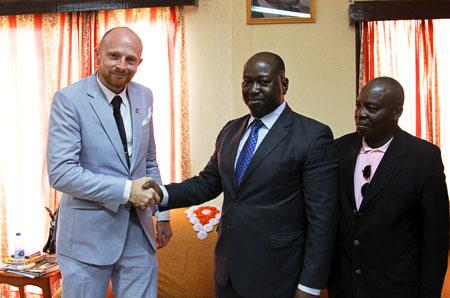Mads Brügger has his own unmistakable style and methods. Over the last 15 years he has repeatedly pushed the envelope of what journalism can, and should, do.
In his new film, "The Ambassador", Brügger takes his method a step further than the role-playing of his previous films Danes for Bush and The Red Chapel. He is not playing a diplomat in "The Ambassador" – he actually is the Liberian diplomat Mads Brügger Cortzen. Says Brügger.
"To show this Africa of the affluent, I use 'performative journalism'. Instead of disguising myself as a fly on the wall, neutrally observing, I dress up for the part and interact as an agent provocateur. With all the intentions of a journalist to expose an overlooked part of the world, I went to CAR as a rich white businessman with diplomatic credentials, pursuing all the perks that come with the title – reckless diamond hunting, power abuse, etc. – and became a respected member of their society.
"Precisely because I'm beyond role-playing by actually being a diplomat, I can forge a partnership with a very sinister diamond-mine owner replete with gold tooth and machete scars on his forehead. That would be highly problematic for a journalist. But it's no problem for a diplomat."
The Devil Is in the Details
Constructing his characters, Brügger consiously and actively works with other people's expectations, drawing on both Jungarian archetypes and recent cognitive neuroscience, especially the concept of mirror neurons that explores how brain cells copy or mirror influences and events around us. "The people around me finish my story – they top my excesses. When I say something 'horrible', they double it," Brügger says. "I play around with archetypes – the 'black' fantasy of a white man – and create a phantasmagorical figure. I code my persona down to the smallest details, in a near-semiotic orgy of meanings.
Indeed. The persona of Cortzen is the product of countless cultural references, everything from Tintin (Dr Müller) to Curious George ("The Man with the Yellow Hat"), Graham Greene's "The Honorary Consul" and Herzog's "Echoes from a Sombre Empire".
As Brügger stresses, this painstaking coding of a character is crucial, even if a lot of it doesn't make it into the film.
"I familiarised myself with the dos and dont's of diplomatic life. It gives me confidence to have the etiquette down pat, like how to wrap a napkin around a glass at a reception."
Add to that, Moët et Chandon champagne, Anne Demeulemeester boots, Dunhill Reds and a silver cigarette holder, not to mention a copy of The Phantom's 'Good Mark Ring'. Plainly, Brügger, when he's out of character, likes to wear the 'Bad Mark Ring', too. As Brügger says, the devil is in the details.
Most of the quotes originate from a master class held by Mads Brügger at the National Film School of Denmark
in September. Edited by Susanna Neimann.
Two Role Plays Brügger Style
Danes for Bush (2004)
This satirical TV series follows two fake personas, Mads Cortzen and Jacob Boeschou, starry-eyed believers in the American way and staunch supporters of President Bush, as they travel around America in a camper to get out the vote for "Dubya". Wearing red blazers and wielding buttons, balloons and bumper stickers, they try to convince ordinary Americans to give Bush four more years.
Worried that he might have made it too easy for himself, posing as a neoconservative in a democratic nation like the US, Brügger next came up with the idea of going to North Korea.
"Danes for Bush". Photo: DR TV
The Red Chapel (2009)
Mads Brügger travels to North Korea with a spastic actor and a comedian as a small communist theatre troupe on a cultural exchange visit. In reality, it’s all a pretext. Their true aim is to describe, from within, how a dictatorship affects everything and everybody on a micro-cosmic level. The Red Chapel met with both fascination and criticism when it first aired on DR. Its blend of black humour and mortal seriousness made the TV series a cult hit in Denmark, though some expressed concern that the North Koreans might be punished now that the troupe had revealed its real mission. The subsequent film version won The World Cinema Docu-mentary Competition at Sundance 2010.
"The Red Chapel". Photo: René Johannsen.


